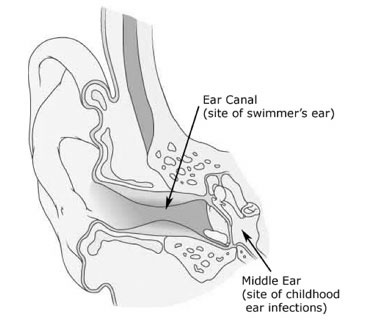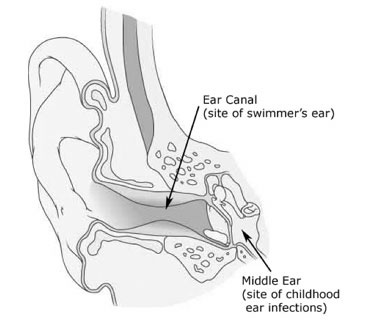
Swimmer’s ear (otitis externa) is a localized infection of the skin of the ear canal. It generally has nothing to do with the types of ear infections young children get (which are behind the eardrum, and treated with antibiotics). It has more in common with diaper rash or athlete’s foot, which occurs in a warm, moist area of the body that are difficult to keep clean and dry. You don’t need to swim to get otitis externa; it can happen from excessive sweating, drainage from a middle ear infection, or even from attempts to clean the ear using Q-tips or other instruments.
Treatment of swimmer’s ear requires careful cleaning of the ear canal to remove wax or other debris that prevents the ear from drying and healing. I prefer to do this with a microscope and small instruments, to allow me to fully examine the ear to make sure that the drum is intact. After cleaning, I usually use eardrops with antibiotics and/or steroids to treat the infection and inflammation. Rarely, the canal can be so swollen that the drops do not get in easily. In these cases, I place a small wick in the canal for a day or two to help the drops get all the way in.
It is important to keep the ear dry during this healing phase. If water does get in the ear, it is best to try to dry the ear canal right away, using a hair dryer or a special ear drying device, such as the Mack’s “Ear Dryer®”. Earplugs can make things worse by trapping wet debris in the ear canal and preventing the ear from drying out if they are worn for a long time. They are fine for a shower or bath, but if you have a bad outer ear infection it's better to avoid prolonged water exposure (like swimming) even with plugs, until the ear has had a chance to heal.
Prevention of swimmer’s ear is usually not necessary, as the normal ear secretes enough earwax to protect the skin and keep it lubricated and healthy. However, loss of this protective coating can lead to progressive inflammation, skin breakdown and infection. Some people find that earplugs can keep this from happening when they swim, although they should not be used once the outer ear is inflamed. Using an ear dryer regularly after swimming can also help those who are prone to this problem.
Another way to prevent swimmer’s ear during times of excessive water exposure is to use a protective solution. One commercial product used by scuba divers is EarShield, a natural oil spray to be used sparingly, available online. You can also make a solution of white vinegar and rubbing alcohol, which can prevent the problem or treat an early case, before you can get to a doctor for an ear cleaning. The alcohol in the solution dries the ear while the vinegar makes it hard for the bacteria which cause swimmer’s ear to grow. The solution should be mostly alcohol, since you don’t need a lot of vinegar to make the solution acidic enough – a few tablespoons of vinegar in a pint of alcohol usually works well. Adding a few drops of glycerin will prevent overdrying. Another way to make this is to get a commercial ear drying drop like "Swim-Ear" (which is alcohol and glycerin) and then add a bit of white vinegar (1/2 teaspoon for the 1 oz bottle).
Use an eyedropper to fill the ear canal and let it sit for a minute. This should not be overused, as it can be irritating and remove protective earwax. The drops can be used after excessive swimming or sweating, but no more than twice a day. Do not use these solutions if there is a hole in the eardrum, in a child with ear tubes, or if there is any significant stinging or burning. Let me know if the pain is getting worse, especially if the redness and itching spread to the outer parts of the ear.

Swimmer’s ear (otitis externa) is a localized infection of the skin of the ear canal. It generally has nothing to do with the types of ear infections young children get (which are behind the eardrum, and treated with antibiotics). It has more in common with diaper rash or athlete’s foot, which occurs in a warm, moist area of the body that are difficult to keep clean and dry. You don’t need to swim to get otitis externa; it can happen from excessive sweating, drainage from a middle ear infection, or even from attempts to clean the ear using Q-tips or other instruments.
Treatment of swimmer’s ear requires careful cleaning of the ear canal to remove wax or other debris that prevents the ear from drying and healing. I prefer to do this with a microscope and small instruments, to allow me to fully examine the ear to make sure that the drum is intact. After cleaning, I usually use eardrops with antibiotics and/or steroids to treat the infection and inflammation. Rarely, the canal can be so swollen that the drops do not get in easily. In these cases, I place a small wick in the canal for a day or two to help the drops get all the way in.
It is important to keep the ear dry during this healing phase. If water does get in the ear, it is best to try to dry the ear canal right away, using a hair dryer or a special ear drying device, such as the Mack’s “Ear Dryer®”. Earplugs can make things worse by trapping wet debris in the ear canal and preventing the ear from drying out if they are worn for a long time. They are fine for a shower or bath, but if you have a bad outer ear infection it's better to avoid prolonged water exposure (like swimming) even with plugs, until the ear has had a chance to heal.
Prevention of swimmer’s ear is usually not necessary, as the normal ear secretes enough earwax to protect the skin and keep it lubricated and healthy. However, loss of this protective coating can lead to progressive inflammation, skin breakdown and infection. Some people find that earplugs can keep this from happening when they swim, although they should not be used once the outer ear is inflamed. Using an ear dryer regularly after swimming can also help those who are prone to this problem.
Another way to prevent swimmer’s ear during times of excessive water exposure is to use a protective solution. One commercial product used by scuba divers is EarShield, a natural oil spray to be used sparingly, available online. You can also make a solution of white vinegar and rubbing alcohol, which can prevent the problem or treat an early case, before you can get to a doctor for an ear cleaning. The alcohol in the solution dries the ear while the vinegar makes it hard for the bacteria which cause swimmer’s ear to grow. The solution should be mostly alcohol, since you don’t need a lot of vinegar to make the solution acidic enough – a few tablespoons of vinegar in a pint of alcohol usually works well. Adding a few drops of glycerin will prevent overdrying. Another way to make this is to get a commercial ear drying drop like "Swim-Ear" (which is alcohol and glycerin) and then add a bit of white vinegar (1/2 teaspoon for the 1 oz bottle).
Use an eyedropper to fill the ear canal and let it sit for a minute. This should not be overused, as it can be irritating and remove protective earwax. The drops can be used after excessive swimming or sweating, but no more than twice a day. Do not use these solutions if there is a hole in the eardrum, in a child with ear tubes, or if there is any significant stinging or burning. Let me know if the pain is getting worse, especially if the redness and itching spread to the outer parts of the ear.
